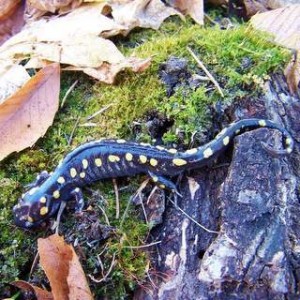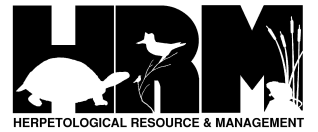Spotted Salamander
Overview:
Scientific Name: Ambystoma maculatum
Size: 4.3 – 9.8” (adult length)
Status: Can be locally abundant where appropriate and intact forest habitat is available, but suffer fast declines or extirpations when woodlands cleared or disturbed. MDNR Wildlife Action Plan Status: Species of Greatest Conservation Need

Habitat:
Moist deciduous or mixed woodlands with closed canopies are preferred. Usually avoid swampy forests where flooding occurs, and uncommon or absent in recently disturbed forests (especially those fragmented by human activities). Habitat must contain or be near temporary or semi-permanent ponds.
Adult Coloration:
Black, dark gray, or dark brown above, with two rows of large, rounded yellow spots running from back of head onto tail. Spots also may appear on legs and snout. Sometimes spots on head are bright orange. Occasionally spots may be white or tan, and rarely no spots are present. Sides are generally unspotted and these and belly are gray or purplish.
Adult Characteristics:
Stout salamanders with broad heads and round snouts. Males usually have slimmer bodies and a swollen vent during breeding season.
Juvenile Characteristics:
Metamorphs are usually dark gray or brown with greenish yellow flecks or patches and dull yellow to tan bellies. Spots appear by the time young salamanders are around 2.4” long.
Larvae Characteristics:
Older larvae (>1.5”) usually greenish gray to brown above with small yellow spots along sides. Tail fins usually grayish with light yellow mottling.
Species Confused With:
Tiger Salamanders are larger and have irregularly shaped splots or blotches that extend to sides and belly. Newly transformed Blue-Spotted Salamanders may exhibit yellow spots, but these are restricted to the sides and belly, while Spotted Salamanders usually lack spots in these areas.
References:
- Amphibians and Reptiles of the Great Lakes Region by Jim Harding
- Harding, J.H. and J.A. Holman. 2006. Michigan Snakes. MSU Extension Ext. Bulletin E-2000,74 pp. [revised].
- Ruthven, A. G., H. B. T. Gaige, et al. 1912. The herpetology of Michigan, by Alexander B. Ruthven. Crystal Thompson and Helen Thompson; Memoranda towards a bibliography of the archaeology of Michigan, by Harlan I. Smith; prepared under the direction of Alexander G. Ruthven. Lansing, Mich., Wynkoop Hallenbeck Crawford, State Printers.
- Holman, J. A. 2012. The Amphibians and Reptiles of Michigan: A Quaternary and Recent Faunal Adventure. Detroit, Mich., Wayne State University Press.
- Conant, R., and Collins, J. T. 1998. Reptiles and Amphibians: Eastern, Central North America. Houghton Mifflin Harcourt Press.
